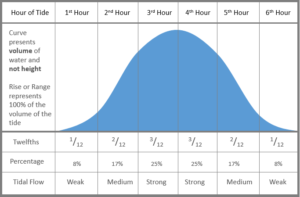It's important to know what the tide is doing as an incoming tide is generally safer ( and more pleasant to swim in ) than an outgoing one.
There are 12 phases of the tide - known as the rule of twelfths - and the water moves at a different speeds at different phases of the tide.
The 12 phases relate to a full tide cycle between low and high tide or vice versa of 6 hours divided into 12
Slack tide is when the water is moving the least and occurs half an hour each side of the top of the tide - either high water or low water.
The water moves quickest at the middle of the tide half way between high or low tide.
As an easy example if high tide is at midday then between 11.30 AM and 12.30 PM the water will be moving with the tide at the slowest speed.
When the tide turns the speed of the water flow will gradually increase over the next 3 hours.
In this example between midday and 1PM it will flow at a rate of 1/12 ( weak ) ,
between 1PM and 2PM it will flow at a rate of 2/12 ( medium ),
between 2PM and 3PM it will flow at a rate of 3/12 ( strong ),
between 3PM and 4PM it will flow at a rate of 3/12 ( strong )
between 4PM and 5PM it will flow at a rate of 2/12 ( medium )
between 5PM and 6PM it will flow at a rate of 1/12 ( weak)
Slack tide will be between 5.30PM and 6.30PM
Low Tide 6PM
Then the tide will turn round and come in at the same rate it went out
SPRING & NEAP TIDES
An added complication is that at different phases of the moon the tide will come up higher and recede lower.
When the moon is full or new SPRING TIDES occur which is when the tide will come up it's highest and recede lowest - this is measured in metres of tide charts.
A FULL moon ( bright whole globe ) occurs two weeks after a NEW moon ( which is dark ) so Spring tides and Neap tides alternate every fortnight.
When the moon is in it's half or three quarter phase then NEAP TIDES occur when the tidal range will be less and the water will not come up as high or recede so far.


